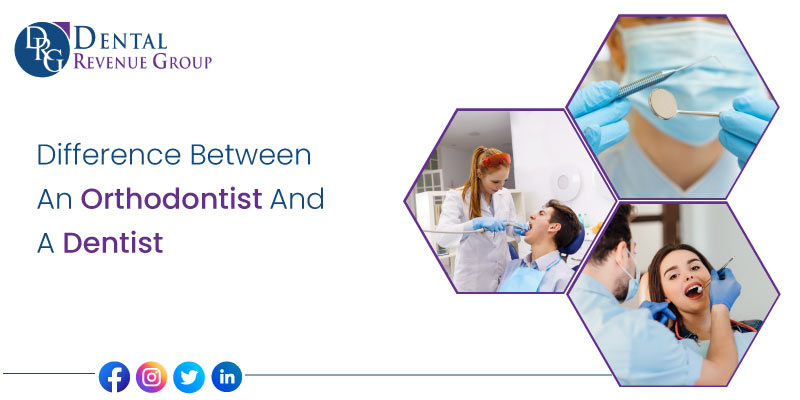When looking for a new dentist, you may be confused about the differences between orthodontists and general dentists. After all, both have similar training, education, and equipment. Dentists and orthodontists are oral healthcare specialists. General dentists are trained to identify and treat problems with your gums, teeth, tongue, and mouth. Orthodontists receive this training as well, but they go on to concentrate on treating and diagnosing inconsistencies in your teeth and jaws. This article will review the differences between orthodontists and dentists so you can determine which type of physician you need to see.
What Does a Dentist Do?
Dentists are oral health specialists. Dentists typically attend college for a pre-dentistry or pre-medical degree before enrolling in a graduate school of dentistry. Dentists must undergo extensive training in their field before becoming certified. Dentists are trained to diagnose and treat problems with teeth, gums, tongue, and mouth. They can also cleanse your teeth, but dental hygienists usually do that.
Educational Requirements
You must first obtain a bachelor’s degree in this field to become a dentist. Licensed dentists must have completed a four-year professional dental school program and a few prerequisite courses. Following that, they will receive one of two degrees: a doctor of dental surgery (DDS) or a doctor of medical dentistry(DMD.) A DDS and a DMD indicate that the dentist graduated from a certified dental school. Both have the same education; it’s just that universities use different names for the same degree. They must also pass licensing exams in the nations where they want to practice dentistry after receiving their degrees. The incentives for those who embrace the dedication and commitment needed for the required qualifications to become dentists go beyond dollars and cents. U.S. News and World Report named dentistry the second-best career in the United States. You’ll understand various services and procedures that your dentist provides and how treatment options can help you achieve a beautiful smile, keep your smile, or restore a smile that has lost some of its sparkles.
Dental Treatments
The dentist’s primary consideration is comprehensive and long-term oral health. But some solutions and treatments that dentists provide can also assist you in achieving the beautiful smile you want to demonstrate to the world. Dentists usually promote good oral hygiene and offer various services such as:
- Preventive measures
- Root canals
- Dental X-rays
- Tooth decay
- Root canals
- Crowns
- Bridges
- Veneers
- Teeth whitening
- TMJ therapy
- Gum disease treatments
- Emergency dental services
What Does an Orthodontist Do?
Orthodontists have got specialization in oral health. They are technically a type of dentist specializing in tooth and jaw alignment. Certified orthodontists are trained to identify and treat dental, gum, and oral health problems. However, orthodontists primarily focus on ensuring that your teeth and jaw are properly aligned. Nearly 20% of dentists in the United States are specialists in a variety of fields, including:
- Orthodontics
- Endodontics
- Dental surgery
- Prosthodontics
- Public’s health
Orthodontists perform the following tasks:
- Misaligned teeth and jaws are diagnosed and treated (malocclusion)
- Braces and retainers treatment
- Carry out tooth straightening surgery
- Install braces, palatal expanders, and orthodontic headgear.
- Chronic headaches
- Supervise facial growth
- Lockjaw
- Bone Damage
Educational Requirements To Become An Orthodontist
Orthodontists must first become dentists. They go through the same educational process as general dentists:
- Bachelor’s degree
Orthodontists who are licensed by the state must also:
- Continue their education for another two to three years in an orthodontic residency program.
- They must first obtain board certification in orthodontics before practice.
Orthodontic Treatment
Orthodontics is a highly specialized subfield of dentistry. Orthodontists frequently employ tools and devices to aid in correcting alignment and advancing healthy jaws, bites, and smiles. Orthodontic treatment is unnecessary for everyone, but it may be required if you have any of the following problems.
Overbites occur when your front teeth protrude beyond your lower teeth.
Underbites occur when your lower teeth prolong too far forward, and your top teeth extend too far back.
Crossbites occur when the upper teeth do not properly come down in front of the lower teeth, resulting in an improper bite.
Spacing Issues occur when there are gaps or spaces between your teeth.
Crowding occurs when too many teeth are crammed into a small space.
Misplaced midlines occur when the centres of your upper and lower teeth are not aligned.
Similarities Between Dentists and an Orthodontists
Dentists and orthodontists are concerned with oral health and keeping your mouth healthy. It’s important to understand that all orthodontists are dentists, but all dentists are not orthodontists. Orthodontists can perform the same duties as dentists and have additional training to specialize in orthodontics.
Distinctions Between Dentists and an Orthodontists
The distinctions between dentists and orthodontists are that dentists will assist you with oral care, tooth decay, gum disease, and procedures such as tooth extraction, crowns, or root canals. Orthodontists can assist you in correcting your overbite, underbite, tooth crowding, and other dental issues. Both dentists and orthodontists play essential roles in keeping your teeth and gums healthy. Patients should be aware that a general dentist giving orthodontic treatment does not have the additional university education, understanding, and experience in orthodontics that a certified orthodontist does.
Should You Consult With An Orthodontist Or A Dentist?
Consider your dentist to be a general practitioner and your orthodontist to be a specialist. An appointment with the dentist can resolve the majority of common dental issues. Your dentist can evaluate and treat tooth pain, tooth decay, tooth repair, and tooth extraction. They can also treat gum disease, oral inflammation, and infectious diseases. A dentist may refer you to an orthodontist in some cases. An orthodontist may be required to treat jaw malocclusion, tooth crowding, and palate expansion. It is also recommended that an orthodontist evaluate all children before seven to determine whether braces are necessary. If you have a crooked jawline or teeth that need to be aligned, you might skip the dentist and visit an orthodontist.
All orthodontic care will not be covered by dental insurance. Sometimes, your insurance company will require a recommendation from a dentist before paying for your orthodontist visit.
Conclusion
You can see many similarities between dentists and orthodontists, even though they have different specialties. Each has specific training that allows them to specialize in treating patients with misaligned teeth and jaws. However, you need to know what type of dentist is right for you before making an appointment so that you don’t get discouraged when things don’t go well during treatment.











